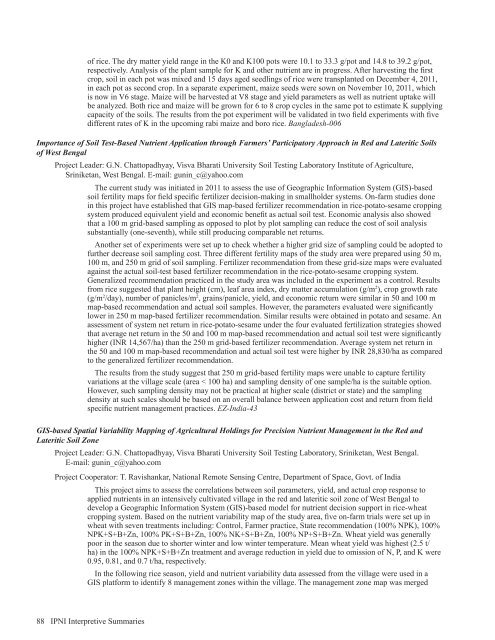Americas and Oceania Group - International Plant Nutrition Institute
Americas and Oceania Group - International Plant Nutrition Institute
Americas and Oceania Group - International Plant Nutrition Institute
Create successful ePaper yourself
Turn your PDF publications into a flip-book with our unique Google optimized e-Paper software.
of rice. The dry matter yield range in the K0 <strong>and</strong> K100 pots were 10.1 to 33.3 g/pot <strong>and</strong> 14.8 to 39.2 g/pot,<br />
respectively. Analysis of the plant sample for K <strong>and</strong> other nutrient are in progress. After harvesting the first<br />
crop, soil in each pot was mixed <strong>and</strong> 15 days aged seedlings of rice were transplanted on December 4, 2011,<br />
in each pot as second crop. In a separate experiment, maize seeds were sown on November 10, 2011, which<br />
is now in V6 stage. Maize will be harvested at V8 stage <strong>and</strong> yield parameters as well as nutrient uptake will<br />
be analyzed. Both rice <strong>and</strong> maize will be grown for 6 to 8 crop cycles in the same pot to estimate K supplying<br />
capacity of the soils. The results from the pot experiment will be validated in two field experiments with five<br />
different rates of K in the upcoming rabi maize <strong>and</strong> boro rice. Bangladesh-006<br />
Importance of Soil Test-Based Nutrient Application through Farmers’ Participatory Approach in Red <strong>and</strong> Lateritic Soils<br />
of West Bengal<br />
Project Leader: G.N. Chattopadhyay, Visva Bharati University Soil Testing Laboratory <strong>Institute</strong> of Agriculture,<br />
Sriniketan, West Bengal. E-mail: gunin_c@yahoo.com<br />
The current study was initiated in 2011 to assess the use of Geographic Information System (GIS)-based<br />
soil fertility maps for field specific fertilizer decision-making in smallholder systems. On-farm studies done<br />
in this project have established that GIS map-based fertilizer recommendation in rice-potato-sesame cropping<br />
system produced equivalent yield <strong>and</strong> economic benefit as actual soil test. Economic analysis also showed<br />
that a 100 m grid-based sampling as opposed to plot by plot sampling can reduce the cost of soil analysis<br />
substantially (one-seventh), while still producing comparable net returns.<br />
Another set of experiments were set up to check whether a higher grid size of sampling could be adopted to<br />
further decrease soil sampling cost. Three different fertility maps of the study area were prepared using 50 m,<br />
100 m, <strong>and</strong> 250 m grid of soil sampling. Fertilizer recommendation from these grid-size maps were evaluated<br />
against the actual soil-test based fertilizer recommendation in the rice-potato-sesame cropping system.<br />
Generalized recommendation practiced in the study area was included in the experiment as a control. Results<br />
from rice suggested that plant height (cm), leaf area index, dry matter accumulation (g/m 2 ), crop growth rate<br />
(g/m 2 /day), number of panicles/m 2 , grains/panicle, yield, <strong>and</strong> economic return were similar in 50 <strong>and</strong> 100 m<br />
map-based recommendation <strong>and</strong> actual soil samples. However, the parameters evaluated were significantly<br />
lower in 250 m map-based fertilizer recommendation. Similar results were obtained in potato <strong>and</strong> sesame. An<br />
assessment of system net return in rice-potato-sesame under the four evaluated fertilization strategies showed<br />
that average net return in the 50 <strong>and</strong> 100 m map-based recommendation <strong>and</strong> actual soil test were significantly<br />
higher (INR 14,567/ha) than the 250 m grid-based fertilizer recommendation. Average system net return in<br />
the 50 <strong>and</strong> 100 m map-based recommendation <strong>and</strong> actual soil test were higher by INR 28,830/ha as compared<br />
to the generalized fertilizer recommendation.<br />
The results from the study suggest that 250 m grid-based fertility maps were unable to capture fertility<br />
variations at the village scale (area < 100 ha) <strong>and</strong> sampling density of one sample/ha is the suitable option.<br />
However, such sampling density may not be practical at higher scale (district or state) <strong>and</strong> the sampling<br />
density at such scales should be based on an overall balance between application cost <strong>and</strong> return from field<br />
specific nutrient management practices. EZ-India-43<br />
GIS-based Spatial Variability Mapping of Agricultural Holdings for Precision Nutrient Management in the Red <strong>and</strong><br />
Lateritic Soil Zone<br />
Project Leader: G.N. Chattopadhyay, Visva Bharati University Soil Testing Laboratory, Sriniketan, West Bengal.<br />
E-mail: gunin_c@yahoo.com<br />
Project Cooperator: T. Ravishankar, National Remote Sensing Centre, Department of Space, Govt. of India<br />
This project aims to assess the correlations between soil parameters, yield, <strong>and</strong> actual crop response to<br />
applied nutrients in an intensively cultivated village in the red <strong>and</strong> lateritic soil zone of West Bengal to<br />
develop a Geographic Information System (GIS)-based model for nutrient decision support in rice-wheat<br />
cropping system. Based on the nutrient variability map of the study area, five on-farm trials were set up in<br />
wheat with seven treatments including: Control, Farmer practice, State recommendation (100% NPK), 100%<br />
NPK+S+B+Zn, 100% PK+S+B+Zn, 100% NK+S+B+Zn, 100% NP+S+B+Zn. Wheat yield was generally<br />
poor in the season due to shorter winter <strong>and</strong> low winter temperature. Mean wheat yield was highest (2.5 t/<br />
ha) in the 100% NPK+S+B+Zn treatment <strong>and</strong> average reduction in yield due to omission of N, P, <strong>and</strong> K were<br />
0.95, 0.81, <strong>and</strong> 0.7 t/ha, respectively.<br />
In the following rice season, yield <strong>and</strong> nutrient variability data assessed from the village were used in a<br />
GIS platform to identify 8 management zones within the village. The management zone map was merged<br />
88 IPNI Interpretive Summaries

















